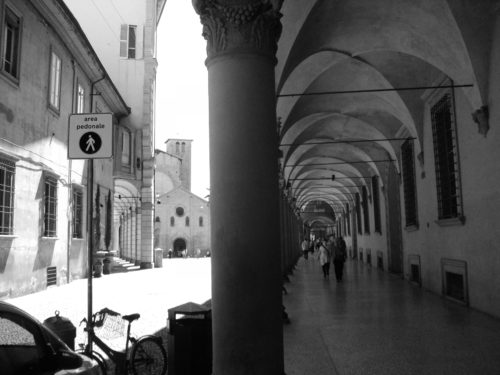I portici di Bologna nel contesto europeo. Convegno internazionale. 22-23 Novembre 2013Bologna porticoes in the European context. International conference. 22-23 November 2013

Venerdì 22 e sabato 23 novembre in Cappella Farnese a Palazzo d’Accursio (Piazza Maggiore 6) si tiene il convegno internazionale “I portici di Bologna nel contesto europeo”.
Bologna è generalmente considerata la città in cui sono presenti, non solo nel centro storico medievale, la maggior quantità di portici sia nell’edilizia pubblica, civile ed ecclesiastica, sia nell’edilizia privata. Un rilevamento effettuato all’inizio degli anni Novanta del secolo scorso ha evidenziato la presenza di ben 38 km di portici nell’area delimitata dalle mura del secolo XIII, a cui si aggiungono i 4 km del portico che collega la città alla basilica di S. Luca sulla collina della “Guardia” e il Portico degli Alemanni (650 m) fuori della Porta di Strada Maggiore. Non è rilevante solo la quantità dei portici presenti in Bologna, ma anche la loro qualità e la capacità di evolversi nel tempo sperimentando di volta in volta gli stilemi architettonici e adattandoli sia all’edilizia più povera sia a quella aulica.
Appare ora necessario confrontare questa realtà bolognese con quanto è stato realizzato in altre città, non solo per valutare l’esegesi dei portici, ma soprattutto per comprendere come, attraverso i secoli, essi si siano evoluti o siano scomparsi, quali condizioni (storiche, sociali, estetiche, topografiche, ecc.) ne abbiano determinato la storia, quale percezione ne hanno avuto gli abitanti e quale sensazione/impressione hanno stimolato nei visitatori, quale sia stata e sia ancora la loro fruizione da parte dei cittadini e di quanti frequentano la città per studio, per lavoro o per turismo.
Fonte: http://www.comune.bologna.it/appuntamenti/notizie/136:24529/The Comune di Bologna, together with the “Centro Gina Fasoli per la storia delle città” (University of Bologna) promotes a two-day conference to discuss and compare different civic situations in which porticoes do (or did) emerge as a peculiar element of cityscapes. The conference will be a useful contribution for completing the dossier concerning the nomination of the Bologna Porticos to the UNESCO World Heritage List.
Today the historic centre of Bologna, that is to say the area included into the city walls of the XIIIth century, contains some 38 kilometres of porticoes build during a long historic period. (through XIth – XXth century). In addition, it is important to mention the 4-kilometer-wall built in 1674, driving to the Sanctuary of the Madonna of Luca, on the hill of La Guardia. Thanks to their great diffusion and permanence, the Porticoes of Bologna are considered as ‘outstanding universal value’.
Their long permanence and use (about 1,000 years) are due to the importance given to these artefacts in the city of Bologna through the centuries.
In the Middle Ages all the developed cities were characterised by porticoes. Generally, this phenomenon is due to the need of space for dwellings and occupation during a period of economic development and, at the same time, to poor control of public space by the authorities. For this reason, between the XIth and XIIth centuries a great number of porticoes were built in public areas: it is the typical case of ‘private use of public space’. At the end of the XIIth century, because of the great economic development of the cities and the population increase, the municipal authorities needed to put their cities in order: further invasion of public space was prohibited and some bulky buildings – or part of them – were demolished. Up to that moment, the history of Bologna was the same as the one of other cities. But the history of its porticoes was destined to change.
Actually, since the XIth century in Bologna there have been some examples of civic building whose porticoes were built on private space, i.e. without taking up public space. Day by day, this important change became a set rule.
At the end of the XIIth century an important change took place: actually it was no more possible to build porticoes (people needed be licensed to use public space). On the contrary, in Bologna porticoes were defined as compulsory for all the streets where they were considered useful on private soil (as Law settled in 1288), also by preserving their public uses; this law is still in force.
In 1363, it was ordered that no wooden porticoes should be built any longer, and in 1567 it was ordered that wooden pillars should be replaced by brick or stone pillars. Nevertheless, there are still extant nowadays some wooden porticoes dating back to the 13th century.
As well as mirroring the housing demand, the development of porticoes is also related, in particular, to the extraordinary development of the university city between 1100 and 1200, when a huge number of students came to Bologna from all over Europe. This gave rise to a typical housing standard: dwellings for students were available on upper floors, whereas shops and artisans’ workshops were located on the ground floor.
All that was possible because the urban community appreciated the possibility of walking on the street sheltered from bad weather and of working ‘en plein air’. Bologna’s porticoes became diffused because they were useful, as it is proved by the captation of a miniature painting of a code of the XIIIth century, which depicts a carpenter working on a quite big object, ‘Iste est magister Nicholaus de Rasiglio qui laborat sub porticu domus sue diebus feriatis et non feriatis’. (A.S. Bo. Carpenter’s Statute, 1264)
Sources and infos:
http://www.comune.bologna.it/media/files/flyer_portici_bologna.pdf
http://www2.le.ac.uk/departments/urbanhistory/news/newsletter/nov2013/bologna-s-porticos
Recent Comments